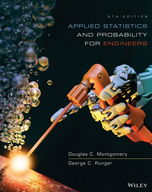Solution Found!
An encryption-decryption system consists of three
Chapter 2, Problem 212SE(choose chapter or problem)
Problem 212SE
An encryption-decryption system consists of three elements: encode, transmit, and decode. A faulty encode occurs in 0.5% of the messages processed, transmission errors occur in 1% of the messages, and a decode error occurs in 0.1% of the messages. Assume the errors are independent.
(a) What is the probability of a completely defect-free message?
(b) What is the probability of a message that has either an encode or a decode error?
Questions & Answers
QUESTION:
Problem 212SE
An encryption-decryption system consists of three elements: encode, transmit, and decode. A faulty encode occurs in 0.5% of the messages processed, transmission errors occur in 1% of the messages, and a decode error occurs in 0.1% of the messages. Assume the errors are independent.
(a) What is the probability of a completely defect-free message?
(b) What is the probability of a message that has either an encode or a decode error?
ANSWER:
Answer
Step 1 of 2
(a)
An encryption-decryption system consists of three elements: encode, transmit, and decode.
A faulty encode occurs in of the messages processed, transmission errors occur in
of the messages, and a decode error occurs in
of the messages.
Assume the errors are independent.
we are asked to find the probability of a completely defect-free message.
Let be the event of faulty encode of the messages processed.
Let be the event of transmission errors occurs in the messages.
Let be the event of decode errors occurs in the messages.
The probability of messages processed has a faulty encode is,
The probability of messages processed does not have a faulty encode is,
……….(1)
The probability of messages processed has transmission errors is,
The probability of messages processed does not have transmission errors is,
………(2)
The probability of messages processed has a decode errors is,
The probability of messages processed does not have a decode errors is,
………(3)
Since the errors are independent.
Hence we can apply the independence rule of probability which is,
If two events and
are independent, then we can write,
……….(4)
Similarly, for multiple events are independent if and only if for any subset of these events,
……(5)
Then by equation (5), we can write the probability of a completely defect-free message,
Using equation (1), (2) and (3),
Hence the probability of a completely defect-free message is
